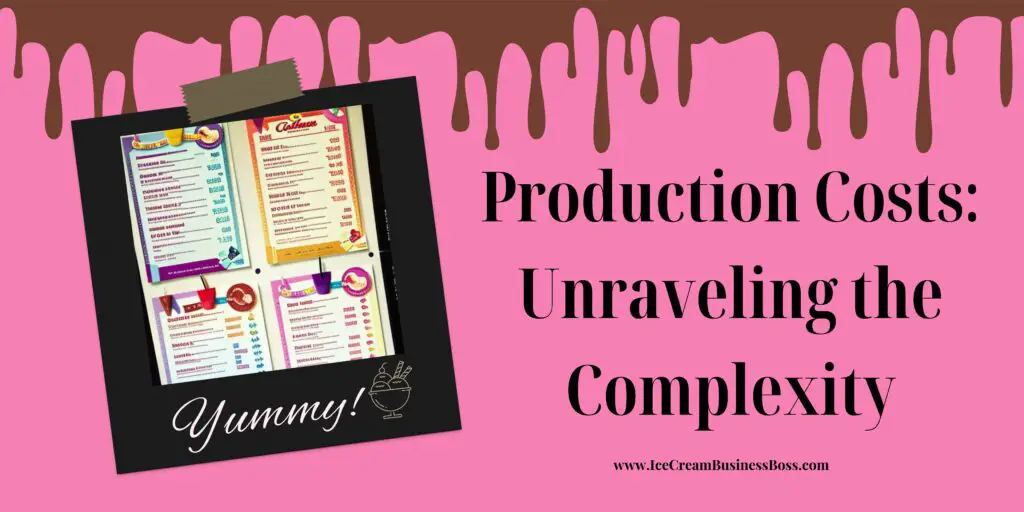In the fascinating world of frozen treats, where every scoop tantalizes taste buds and brings smiles to faces, there is a sector of business complexities that sometimes go overlooked. A delicate interplay of financial aspects influences the fate of ice cream manufacturing firms behind the scenes of creating those exquisite ice cream masterpieces. The concept of profit margin – a statistic that encompasses the essence of financial performance within the industry – is central to this complicated dance.
To effectively manage ice cream manufacturing’s financial growth, you should start by understanding the profit margin range (10% to 20%) impacted by production costs, distribution, and pricing strategies.
This article delves into the fascinating world of ice cream manufacturing profit margins, investigating their significance, the factors that influence them, and the techniques that can lead to their optimization. So, let us begin on a journey that not only fulfills our curiosity but also provides a greater understanding of the creamy economics that underpin every bite of ice cream we consume.
The Essence of Profit Margin
At its heart, the profit margin represents a critical and fundamental metric that cuts across industries and sectors and provides deep insights into a company’s innate capacity to convert undifferentiated revenues into real profits.
This metric assumes an even more prominent relevance in the world of ice cream production, a delicious and cherished delicacy enjoyed by many people. It acts as a dependable compass, expertly directing decision-makers toward tactical options with the potential to have a significant impact on the company’s overall financial trajectory.
The idea of a profit margin captures the delicate dance that takes place within the complex web of commercial activities. As a complex indicator, it illustrates the delicate balance between the expenses acquired inexorably during the production process and the painstakingly determined selling price that is attached to the finished goods. This constantly moving and multifaceted balance captures the core of a prosperous and effective firm.
Due to the distinct market dynamics that underpin the ice cream production industry, the profit margin’s relevance is amplified significantly. Ice cream making, a combination of art and science, necessitates careful consideration of ingredients, production methods, and product distinction.
A healthy profit margin can explain the complexities of production costs, from the acquisition of premium dairy and flavoring ingredients to the expenditures related to packaging and freezing technologies. Decision-makers develop a deeper grasp of the underlying mechanisms that influence the final cost structure of their frozen delicacies by closely examining these expenses.
The profit margin also has an impact on market trends and consumer preferences at the same time. Ice cream producers must navigate a market with frequent swings in demand as discriminating consumers desire a variety of flavors, formulas, and dietary preferences.
Companies can use pricing strategies that can either strengthen or weaken their competitive edge thanks to the deliberate formulation of a selling price anchored in the complexity of manufacturing expenses. Manufacturers may wisely balance pricing with customer expectations when they have a well-calibrated profit margin, which promotes brand loyalty and market resilience.
The profit margin acts as a link between an ice cream manufacturing company’s internal workings and the larger economic ecology. This statistic offers a comprehensive picture of the company’s financial health when compared to other financial metrics. It gives decision-makers a wide canvas on which to paint creative expansion, diversification, or even recalibration plans.
Check out this article to learn more about an ice cream truck business’ profit margin.
Production Costs: Unraveling the Complexity

Any ice cream manufacturing business is built on a complex and nuanced production process. This method orchestrates the transition of raw ingredients into a frozen treat that tempts the taste receptors. It combines artistry and precision.
However, the production costs—a crucial factor that forms the delicate balance between costs and profitability—bear weight on the canvas upon which this delicious masterpiece is created. A thorough comprehension of this complex relationship is essential for both creating decadent sweets and fostering a thriving business.
The economic realities of production costs control the process of making ice cream, despite it being a lovely symphony of flavors and textures. The purchase of premium ingredients, the laborious work of experienced labor, the hum of energy-guzzling machinery, and the protective hug of packaging are all included in this cost range. Each component adds a stroke to the financial canvas, an amalgamated picture that affects the final balance of earnings and expenses.
The mixture of components that characterizes each ice cream creation is at the heart of these production costs. These elements, which come from numerous sources, come at a variety of prices that reverberate throughout the economy.
The caliber and place of origin of these ingredients are crucial because they not only improve the flavor profile but can also raise the price. The careful selection of ingredients, which has a significant impact on the profit margin, is the key to striking the delicate balance between enjoyment and cost.
Efficiency emerges as a driving principle that dances across labor and equipment in the creation of ice cream. The effects of labor expenses can be reduced by effectively allocating human resources, from the artists who blend flavors to the technicians who maintain machinery.
Similar to this, using cutting-edge equipment and streamlining production procedures results in increased productivity and lower energy usage. These subtleties combined create a cost symphony that resonates with financial caution, enhancing the possible profit margin.
Manufacturers engage in a symphony of optimization by breaking down the complex elements of production costs, which reverberates throughout the financial world. Manufacturers can fine-tune their operations by adding techniques that reduce waste, improve efficiency, and prevent avoidable expenditures by carefully examining each cost component like an artist would analyze the hues on a palette. These tactical choices, from sourcing ingredients to purchasing energy-efficient equipment, resonate with the soaring profit margin.
Distribution: Bridging the Gap

From the precise manufacturing process to the eager hands of consumers, ice cream travels through a complex network of distribution that is of utmost significance in forming the delicate balance of profit margins. Distribution costs are a crucial element that runs through the fabric of profitability.
They are a tapestry made from the threads of transportation, storage, and handling costs. Whether bound for the cozy corners of neighborhood ice cream shops or the chilly confines of supermarket freezers, the careful management of distribution costs emerges as a factor that significantly affects the bottom line.
The careful orchestration of supply chain management appears as an artistic dance in the modern business landscape that can be the difference between achievement and failure for a company. The financial ledger is influenced by the decisions made within distribution routes, the frequency of deliveries, and the geographic scope.
For instance, using direct distribution methods for small-town stores offers the prospect of lower distribution expenses. The rationalization of the delivery procedure in this case may result in a strengthening of profit margins.
Comparatively, establishing a wider distribution network might result in higher expenditures, but the resulting rise in sales volume might be able to balance this financial equation. The balance struck between cost reduction and distribution effectiveness is a strategic directive that strongly reverberates within the halls of ice cream production.
Beyond simple logistics, the distribution stage of ice cream projects unfolds as a story of tactical scheming. The decisions conceal subtle nuances, each one a brushstroke adding to the growth’s canvas. While increasing efficiency, a direct-to-retail strategy may require complicated negotiations with merchants. Alternately, a larger distribution network may require the creation of strong alliances with distributors and agents, each link in the chain having the potential for financial gain.
The distribution sector has an impact on market dynamics and customer behavior. Accessibility is influenced by geography, thereby broadening the brand’s scope. Carefully calculated delivery frequency guarantees the availability of fresh stock, a factor that supports customer happiness and repeat business. Because of this, the distribution landscape is ornamented with the remains of strategic forethought, where each choice has an impact on profit margins and customer experiences.
Check this article to learn more about the profit margin of an ice cream franchise.
Pricing Strategies: The Art of Valuation

To create the ideal price for an ice cream product, production costs, consumer perceptions, and market trends must be carefully balanced. This harmonious combination of components serves as the building block for pricing strategy, where accuracy is crucial to avoid the risks of undercutting profits or alienating potential clients.
A direct result of the choices woven into the fabric of pricing strategy, the profit margin emerges as the crescendo in this complicated ballet, solidifying its position as a key component in the financial playbook of ice cream manufacturers.
The colors of consumer behavior, rival prices, and the nebulous idea of perceived value are painted on the canvas of pricing strategy. It takes not only artistic talent to solve this complex puzzle but also extensive knowledge of the subtleties that control market dynamics.
Ice cream producers walk a delicate balance between setting prices that reflect market trends and the pulse of their target market’s willingness to pay. Every potential customer brings their lens through which value is viewed, and pricing strategy is weaved into this kaleidoscope.
As transitory as the air that delivers them, the seasons also add their tunes to the pricing symphony. Ice cream producers use seasonal trends and unique offers in this market to create an atmosphere that is in tune with the current mood.
These tactical moves are essential because they not only increase the appeal of products during specific times but also affect how price elasticity behaves. The formula for pricing strategy must continue to be flexible and responsive to the market’s ever-changing tides of supply and demand.
Ice cream, which comes in a wide variety of flavors, lives on distinction. Manufacturers embrace the art of product diversification to highlight their distinctive offers, and pricing strategy is no exception. This aspect adds complexity to the pricing narrative, allowing producers to choose price points that reflect the value inherent in their products, whether through unusual flavors, high-quality ingredients, or inventive packaging.
The key issue, however, continues to be finding a balance between offering competitive pricing and preserving a desirable profit margin. Pricing strategy becomes a negotiation that crosses the boundaries of market dynamics and consumer psychology in a world where consumers are value- and price-conscious. To navigate this terrain, one needs both dexterity and a data-driven plan, where insights from consumer preferences, rival actions, and financial projections are combined to create a thorough price strategy.
Frequently Asked Questions
What are the usual profit margins in the ice cream manufacturing industry?
Ice cream production profit margins typically range between 10% and 20%. After deducting manufacturing costs, distribution fees, and other operational charges, this range shows the percentage of sales that transfers into profit. The exact margin, however, can vary depending on factors such as manufacturing efficiency, ingredient costs, and pricing tactics.
How do production expenses affect profit margins in the ice cream manufacturing industry?
Production costs include a wide range of expenses such as raw materials, labor, energy, machinery, and packaging. These expenses have a direct impact on the profit margin since they determine how much revenue remains after deducting expenses.
Manufacturers with excellent cost management and optimization might attain a better profit margin. Ingredient sourcing with care, effective machinery usage, and expert labor management all contribute to a healthy profit margin.
What role does pricing strategy play in the financial growth of ice cream manufacturing?
Pricing strategy is an important factor in defining an ice cream manufacturing company’s profit margin and overall financial growth. Ice cream prices must take into account elements such as production costs, consumer perception, competitive pricing, and market trends.
It is critical to strike the correct balance between delivering competitive pricing to attract clients and retaining a profit margin to continue business operations. Pricing methods that are effective ensure that products are priced in a way that represents their worth and remains appealing to the target market.
The information provided by IceCreamBusinessBoss.com (“The Site”) is for general informational purposes only. All information on the Site is provided in good faith, however, we make no representation or warranty of any kind, express or implied, regarding the accuracy, adequacy, validity, reliability, availability, or completeness of any information on the Site. Under no circumstance shall we have any liability to you for any loss or damage of any kind incurred as a result of the use of the Site or Reliance on any information provided on the Site. Your use of the Site and your reliance on any information on the Site is solely at your own risk. This blog post is for educational purposes only and does not constitute legal advice. Please consult a legal expert to address your specific needs. Terms and Conditions.

Hi! I am Shawn and I am a happy individual who happens to be an entrepreneur. I have owned several types of businesses in my life from a coffee shop to an import and export business to an online review business plus a few more and now I create online ice cream/gelato business resources for those interested in starting new ventures. It’s demanding work but I love it. I do it for those passionate about their business and their goals. That’s why when I meet a ice cream/gelato business owner, I see myself. I know how hard the struggle is to retain clients, find good employees and keep the business growing all while trying to stay competitive.
That’s why I created Ice Cream Business Boss: I want to help ice cream and gelato business owners like you build a thriving business that brings you endless joy and supports your ideal lifestyle.

